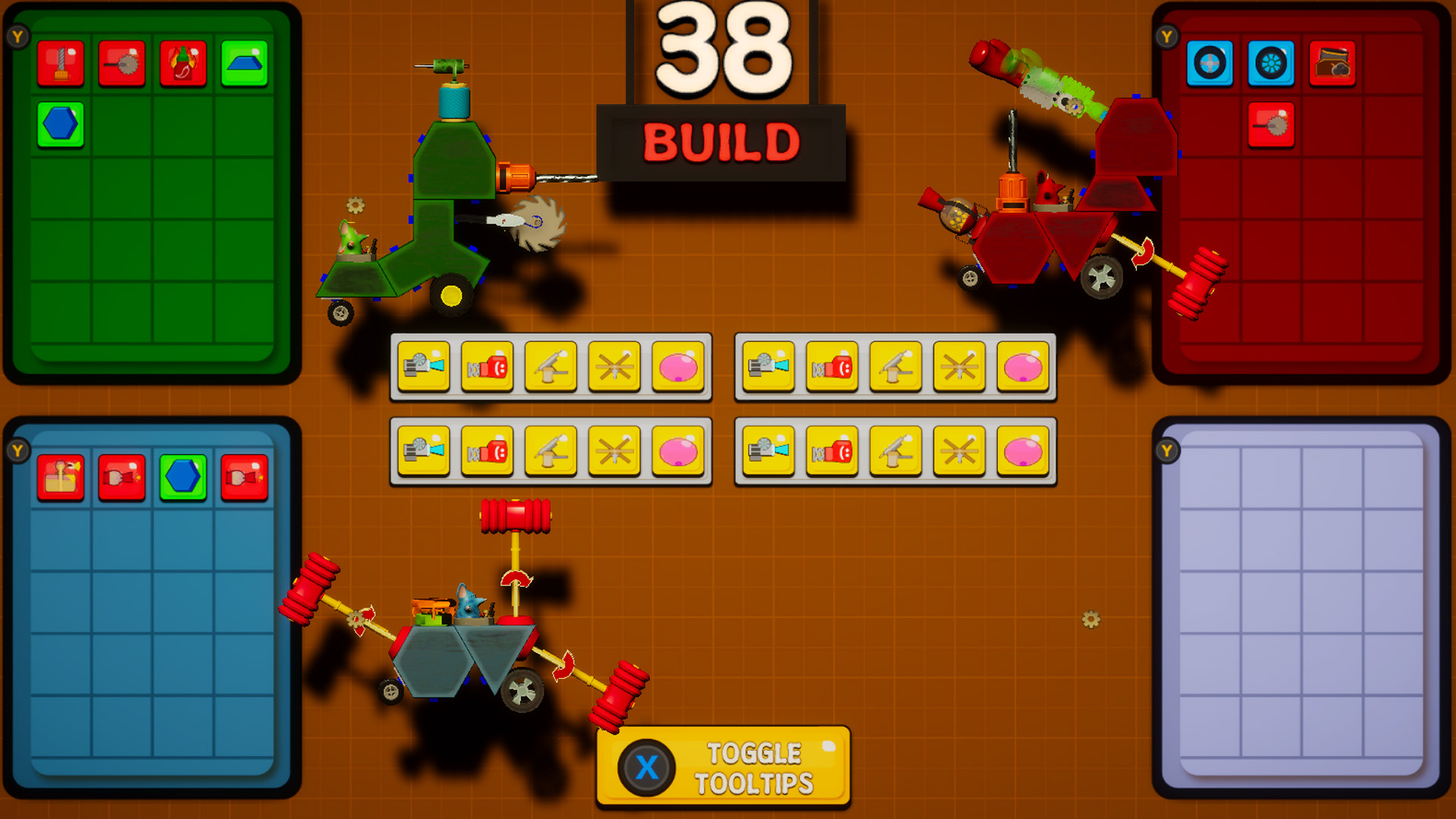Cheesepunk - Play on Itch!

- Platform: PC (full controller support)
- Engine: Unity
- Playtime: ~15 minutes per game
- Download: Itch.io
Project Overview
“CHEESEPUNK is a competitive and chaotic couch party game for 2 - 4 players. Each player takes the role of a Genius Mouse Engineer on the hunt for parts to create a BattleBot capable of removing any foes that stand between them and the cheesy rewards they desire.”

Roles and Responsibilities
I served as the lead systems designer & technical designer. I oversaw development of the entire component system from models, sounds, design, and much of the programming. I also assisted in programming various game features where possible & created various 3d models in my free time to assist the art team. I was also responsible for organising various playtesting sessions & balancing the game.
I was responsible for documenting game systems into the game design document, as well as market research for the project.
- Research was based upon audience statistics from similar games (C.A.T.S, Ultimate Chicken Horse, Mario Party).
- Documentation was formatted as one encompassing document in Microsoft Word, with each mechanic having its own header & written in dot points for readability.
I was responsible for keeping our 16 weapons in check, so that they all had a distinct use case while none overpowered any of the others.
- Initial balancing metrics were created in an excel sheet, with each item being scored upon various factors:
* Base damage
* Damage over time
* Weapon reach
* Weapon modifiers (initial estimates were made - modified after playtesting)
- Excel was also used to keep track of weapon modifiers, so that each weapon was distinct from every other weapon in the game.

As the technical designer on the team, it was my responsibility to create a modular system so that the process of implementing new weapons into the game was simple and the designers without a technical background could easily implement new weapons into the game.
- I decided to utilise Unity's component system to break weapons down into common effects and utility scripts.
- A weapon would have 1 of 3 base types: melee, spawner, & ranged. This would determine how the 'onHit' event was triggered.
- You could then add various effects to the weapon: damage over time, instant damage, knockback, stun. This would determine what the weapon does when the 'onHit' event is triggered.
- Lastly you could add utility scripts to the weapon: spinning, growing, weapon indicators. This would determine visually how the weapon behaved.
As the technical designer on the team, it was my responsibility to prototype intended game mechanics as soon as possible, that way the team had the best chance of knowing whether we were headed in the right direction.
- I was responsible for prototyping the battle phase of the game in early development.
- I prototyped various movement mechanisms for moving battle bots around the arena, as well as various scoring systems, and methods for handling the battle bot physics.
As the technical designer on the team, I also helped program various systems within the game so that our only programmer could focus more on the larger more important systems within the game.
- I was responsible for programming several of the weapon effects available in the game such as: Damage over time, Explosives, Knockback, Grapple & others.
- I was also responsible for initially implementing movement mechanics for the battle bots including: movement, jumping & battle bot disassembly until our programmer got a proper chance to polish those mechanics.
- I also assisted in setting up various level effects throughout the scramble mode as well as assisting with various other sub-mechanics within larger game systems.
As the lead on component design, I also took on the responsibility of 3D modelling most weapon components to ease the load on the limited artists we had available.
- 3D modelling was done in Maya and exported to Adobe Substance Painter for texturing.
- I 3D modelled and textured:
* Hammer
* Drill
* Tesla Cannon
* Match stick
* Grenade Launcher
* Plunger
* Fireworks Launcher
* Fondue Hose
* Hot Sauce
* Grappling Hook
* Freeze Ray
* Shield Bubble

As the lead on system design, it was often my responsibility to organise playtesting sessions for the team. Sometimes this involved getting fellow class mates to play the game, otherwise I would often bring Cheesepunk to 'Pizza and Pixels' a local game dev meetup help once a month. I also applied and got accepted for Cheesepunk to be showcased at CMAG (Canberra Museum and Gallery) for a game dev event, where 14 games were selected to be shown to the public.
- Recording feedback from playtesting involved, taking notes of player behaviour during sessions without guiding them on how to play the game as it was important that people could pick up and figure the game out on their own.
- Afterwards I would ask them a couple of questions, about the experience.
- Playtesting was invaluable for the team and allowed us to:
* Completely revamp the controls.
* Redesign the jump ability to be more powerful.
* Completely overhaul how players earned and used activatable weapons.
* Balance the weapons to an acceptable level of power.

Programs used working on the project





